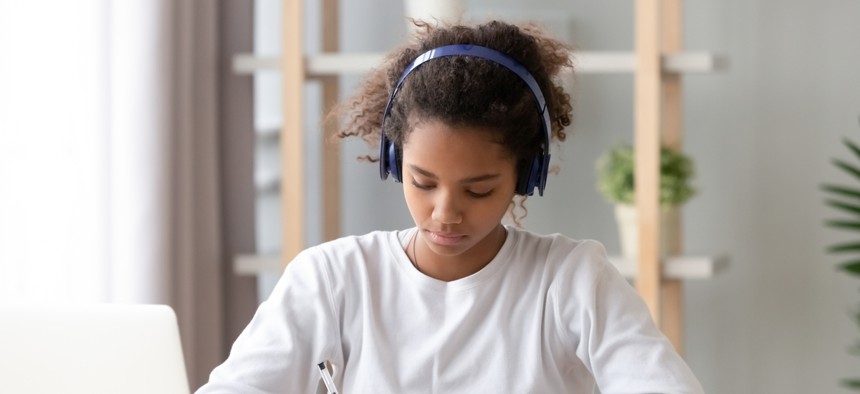School House Rocked: How Covid-19 Could Change the Way We Teach and Test

School curriculums haven't matched the needs of the workforce. With disruptions to the way we educate in light of Covid-19, now is the time to ensure curriculums better prepare students for the workforce. SHUTTERSTOCK
COMMENTARY | If we want to prevent long-term economic suffering, we should rethink our K-12 education system.
The usual hustle and bustle of daily life has come to a screeching halt due to Covid-19, giving us the opportunity to press pause, assess the way things currently are, and think about what should or will change when we regain some of our usual routines.
One of the most obvious changes coming to American life is the way we work. Already, some employers are considering making the coronavirus-inspired shift to remote work a permanent change, having seen little disruption to daily productivity. But many American businesses that depend on in-person employees and in-person patrons are facing an uncertain and difficult future given social distancing measures that will continue to be in place until a vaccine is available. That coupled with the signs of continued instability in the economy, it’s quite possible that this could be the most difficult job market the country has ever faced.
As the job market changes, so too must our approach to preparing the future workforce through our K-12 education system. Even before coronavirus swept the nation, school curriculum wasn’t aligning with the greater needs of the workforce. For instance, the manufacturing industry had a record high of 522,000 jobs remain open last year. Similarly, the IT sector had 918,000 jobs go unfilled. This doesn’t even mention the extreme shortage of nurses that have been highlighted during Covid-19.
Employers have long waited for the education system to catch up. One survey found that 66% of HR decision makers think high schools aren’t doing enough to prepare students for a career after graduation. But there was little push for schools to change since graduates were still going to college and overall unemployment remained low.
Now, with millions of Americans unemployed—and some likely to stay that way even after communities start to reopen—businesses that are hiring will have the ability to pick and choose the most prepared job candidates.This means schools will have to do a better job making sure their students are among them.
While schools are scrambling to rethink how they educate kids during Covid-19, they might want to consider implementing the instructional method called Career Readiness Education (CRE). In a CRE, electives are reimagined to help students explore an industry of interest, then get an early jump on gaining relevant skills through Career Technical Education (CTE). According to the National Center for Education Statistics, the unemployment rate among high school graduates who earn at least 3.00 CTE credits is lower than the unemployment rate of those that earn fewer CTE credits.
CRE students work in teams, to complete industry-specific certifications at many of the country’s Destinations Career Academies. For example, healthcare students get prepared to take the pharmacy technician certification exam and develop professional skills through work-based learning opportunities like job shadow experiences, internships and externships. And rather than learning from a teacher who doesn’t have any personal familiarity with that particular industry, schools with the strongest CRE programs partner with organizations that have former industry professionals serving as certified instructors.
Stronger CRE options might also result in a greater push for stronger online K-12 learning options. If a large part of the workforce remains remote, experience working in an online environment will be something employers are looking for in job candidates. Compared to an in-person office environment, a virtual one requires even stronger time management, accountability and self-starting skills. Employers will be on the lookout for candidates with these attributes, and parents will want their children to gain those skills, either by enrolling them in a virtual program, or demanding that their district provide a thoughtful blend of in-person and virtual instruction.
A shift in the nation’s approach to K-12 instruction will also initiate a much-needed change in the way we measure student success. Long before Covid-19, critics of standardized testing have argued that those assessments don’t adequately meet the unique needs and abilities of all students, and that they rely too heavily on recall, which isn’t high on employer’s list of desired skills, rather than application.
The same survey of HR decision-makers found that “soft” skills like work ethic, communication and teamwork are among the most highly desirable. But those aren’t the kinds of skills that get measured on standardized tests. Rather, those skills are assessed through interviews and internships, which a K-12 education paired with a robust CRE program provides students with opportunities to experience.
A reform of American education has been sorely needed for decades. Could Covid-19 pave the way for us to finally ensure we have the skilled workforce ready to compete for the jobs of tomorrow? That should certainly be our aim.
Dr. Shaun McAlmont is president of career learning solutions at K12 Inc.
NEXT STORY: Preparing Your Mind for Uncertain Times





